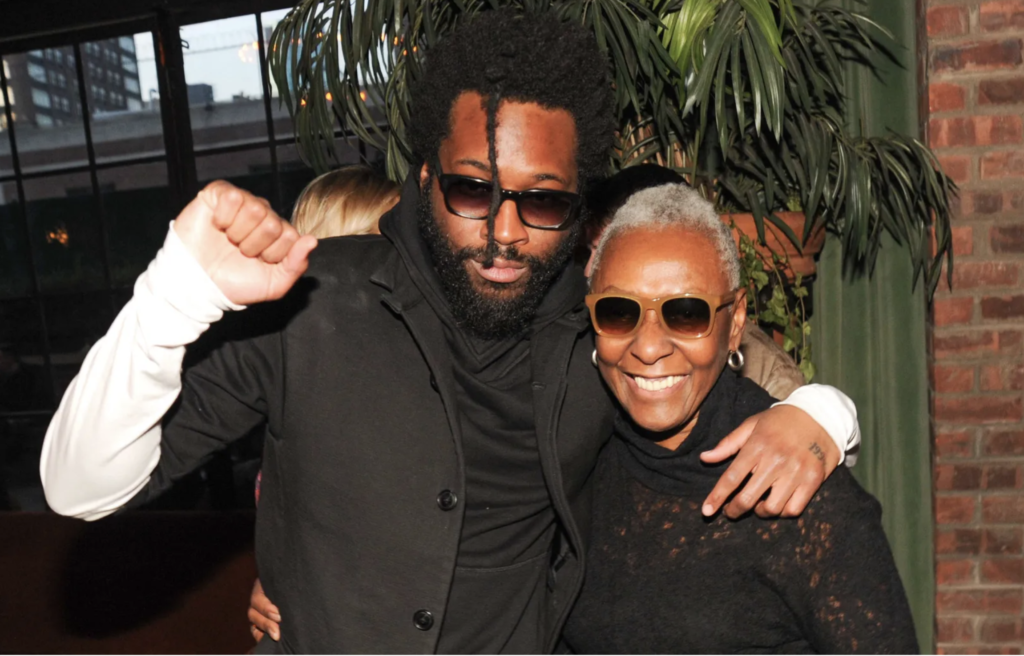Designer Maxwell Osborne and Legandary Model Bethann Hardison Get Real At LAFW
- By: Brianna Rose Hewitt
- October 24, 2023
“Like I can only talk through clothes”…
They say there’s a fine line between love and hate, and words do not ring more true when it comes to the fashion industry. Behind the glamor and trends, there is a world of creatives exploring their purpose and fighting to get their art seen. No one knows that more than designer Maxwell Osborne and model and activist Bethann Hardison.
The pair sat down for a fireside chat at Los Angeles Fashion Week to share about their professional journeys and life stories. Most of the conversation centered around Osborne. A Brooklyn native, the designer explained that his fashion journey “Started with the love of clothes.”
“Being a designer was not something you could ever dream of until Fubu and Sean John and Phat Farm actually started,” he said, “where people like us could be a designer.”
The menswear icon continued on to share his story of working at Tommy Hilfiger at 17 years old and eventually moved onto Sean Jean as an intern. The internship led to professional positions until he left the company at 25 before starting his first brand, Public School, with business partner, Dao Yi-Chow. Now, he is the head designer of his brand AnOnlyChild. Loop Magazine was able to secure seats for this interesting conversation, so keep reading for some top moments.ne

Just like the fine line between love and hate, the saying that “money makes the world go around,” applies heavily to the fashion industry. Funding is the top struggle for emerging designers, and Osborne said that he and Yi-Chow actually self-funded Public School. However, the process was not pretty. Osborne and Yi-Chow locked themselves away in an apartment so much that emerging for events like a friend’s birthday was disorienting.
Why would one put themselves through such extremes? The answer is passion. Both Osborne and his partner knew that Public School had value because it was “a brand that broke through the noise of everything that looked the same.” When reflecting on the early days, the Brooklyn native explained there was such a dichotomy between high and low fashion and what was expected of certain designs, but they rebelled against these standards.
“Like why can’t we wear slacks and a leather jacket and not be called ‘urban wear?’ And like, why does it have to sit at this price point or why does it have to be compared to certain brands because we are both people of color,” Osborne demanded to the intimate crowd.
Public School did go on to have successful collections, but eventually fell with financial constraints as well as mental constraints as both Osborne and Yi-Chow took on roles at DKNY. The exhaustion took its toll to the point that Hardison even queried why the former Public School designer would throw himself back into the fashion world with his latest brand, AnOnlyChild.
“I can’t do anything else. It’s just in me. As much as I would love to do something else, like I wish I studied business, you can’t just live without getting it out of your head,” Osborne responded.
And Osborne has definitely found his purpose when it comes to AnOnlyChild. It’s about more than the garments, but rather the feelings around them, especially with a support system. It’s “focused about that, like a feeling, more than the clothes. That’s when it became easier,” The AnOnlyChild founder explained. “We always talk about ‘it takes a village to raise an only child,’ because I am an only child because there’s always people behind you, and there’s a plethora of people who will always support you, that will always hold you down.”

Osborne then continued to talk more about his family: “I’m Jamaican, so there’s mad aunts and uncles and cousins. But that’s why you actually do it, and that’s just by talking. Like I can only talk through clothes more than a panel, more than anything else. That’s my soapbox.” AnOnlyChild gets him through the door to have an impact on the issues he cares about.
And his soapbox encompasses not only the feelings of family but also the importance of sustainability. During the interactive Q&A, Osborne’s own PR person challenged him by asking why AnOnlyChild should remain important in 20 years when the world already has too many clothes. After jokingly telling the team member, “I hate you, Nate,” Osborne got serious and rose to the challenge of the question:
“Everything with AnOnlyChild, we don’t make any fabric. We actually just take from deadstock and remake it, for textiles, taking two fabrics and remaking it. Making new fabrics from nothing, so taking from the past to the future. […] We try to think of the brand as a solve and a storytelling solve. We want to make it a village, we want to make it a community.”
Throughout the chat, Hardison kept Osborne and the audience on their toes. The crowd excitedly asked her questions in addition to Osborne, and at 81 years old, she’s not slowing down anytime soon. She just released a film entitled Invisible Beauty, which was also screened at LAFW. What’s next? Well, she wants to have a foundation and a building with a name on it, dedicated to supplying knowledge to people who want to pursue design and the business of it.
“I’m not leaving here without you knowing who I am,” she says to an applauding crowd. She wants a legacy. “When people say, ‘What was her name again?,’ someone can say ‘did you see the building?’”
Finally, she wants to live a life where she lives four months in Mexico, four months in New York, and four months in Morocco. She also plans to star in a one woman show.
Already so accomplished, there’s so much the future still holds for Osborne and Hardison. We are eagerly awaiting the next An Only Child drop following LAFW as well as the news of Hardison’s foundation and one woman show.



